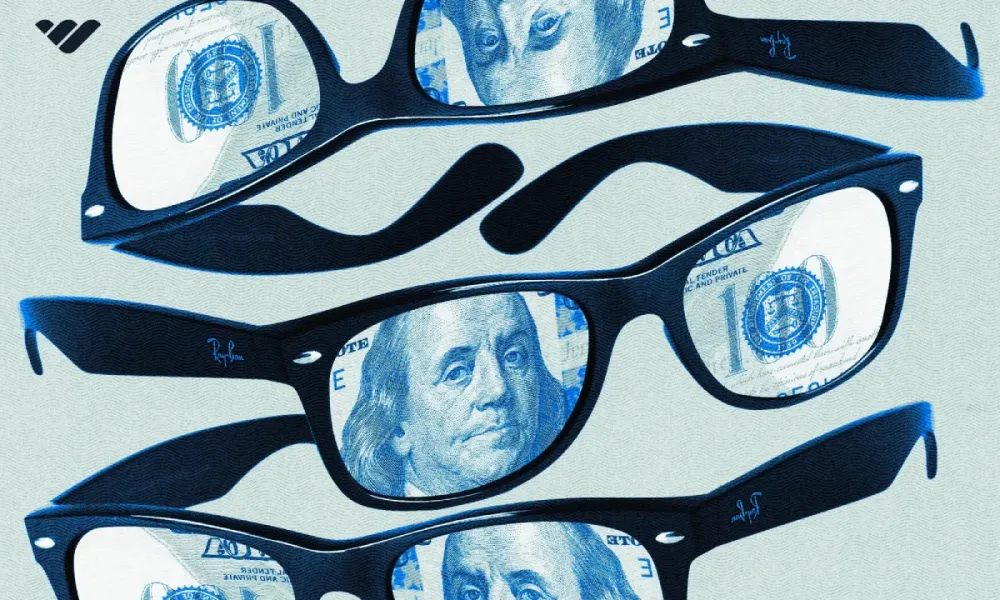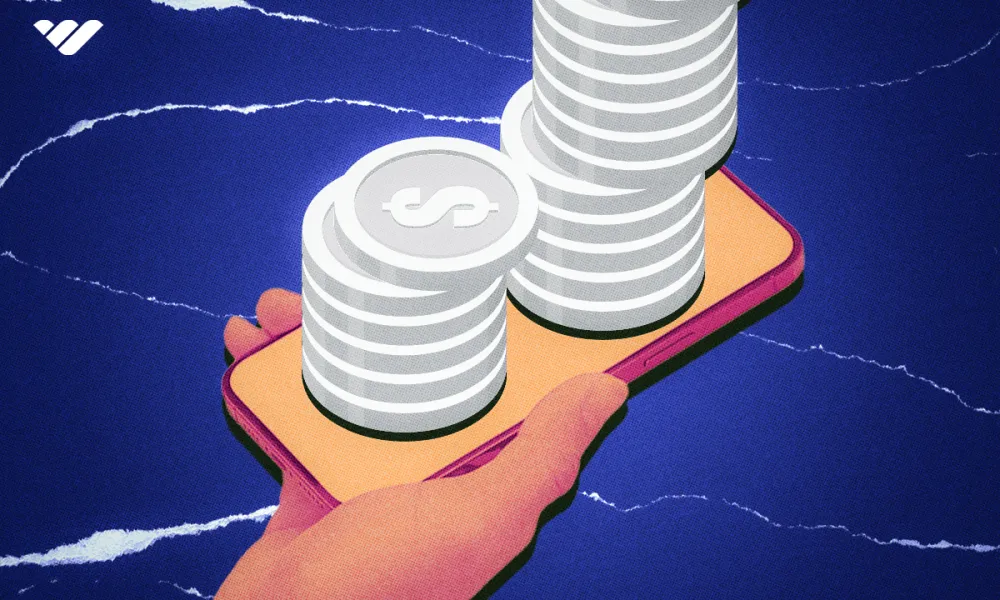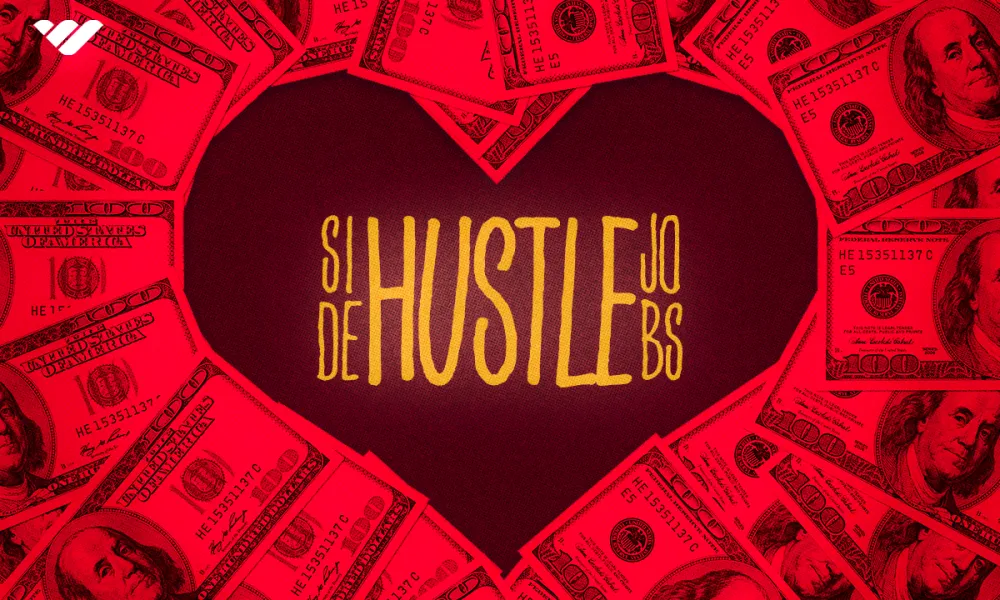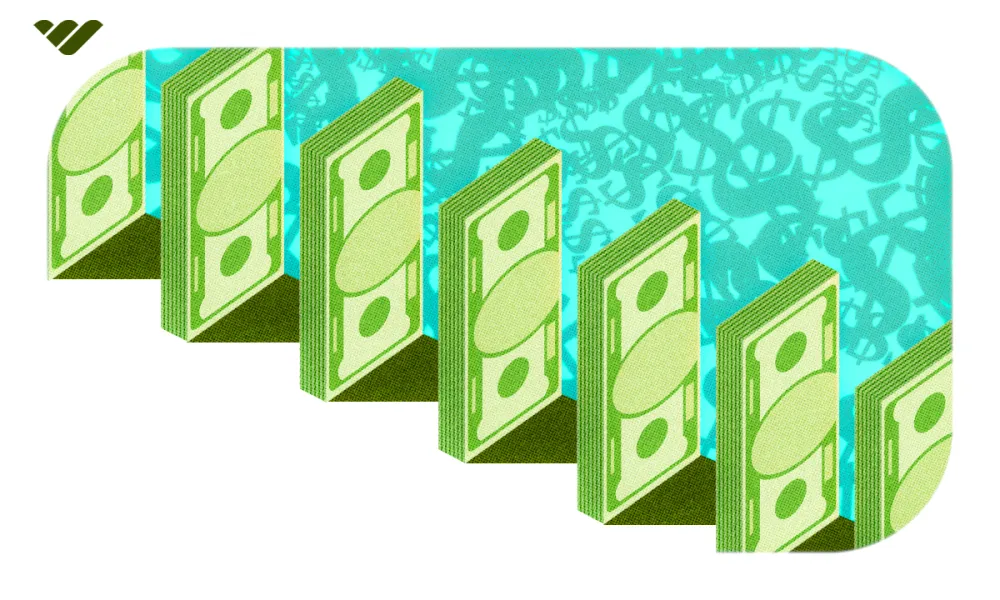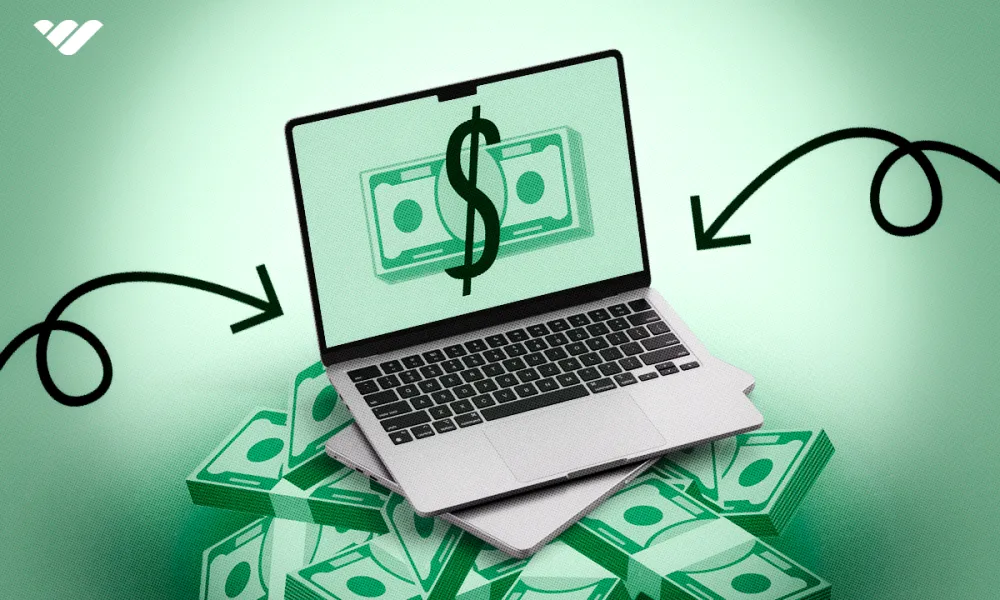Discover the power of Master Resell Rights (MRR) products in this beginner's guide. Learn how to start selling digital products like ebooks, courses, and more with no extra investment.
Master Resell Rights products have been around for a while, but they’re really blowing up lately. Now that setting up an online store is so quick and accessible with platforms like Whop, it makes sense that quick and accessible products would pop up too.
In the physical product world, dropshipping fills that niche because you can sell whatever you want without ever touching a product yourself. In the digital product world, it’s all about MRR products.
All you need to do is buy the product and its resell rights and put it up for sale in your store as is. And since they’re digital products, no restocking, maintenance, or extra investment is needed—they’ll just keep selling forever!
But, as simple as MRR products are, you still need to know what you’re doing to be successful.
In this guide, I’ll show you exactly what MRR products are, what you need to know about them, and which products are most popular.
What are Master Resell Rights (MRR)?
When you buy a product with Master Resell Rights, it means you can resell it and keep 100% of the profits. You can’t say you made it yourself, but you also don’t need to say where you got it or tell people that it’s not an original product.
The resell rights can also be passed on to anyone else who buys it, so if you sell MRR products to your own customers, they can also resell them if they want.
MRR products are particularly popular in the digital product industry. This includes things like online courses, ebooks, templates, software, and more.
So, say you run a whop offering various online courses but you feel like you don’t have enough products. Easy peasy: Just buy a few MRR courses to expand your catalog without having to make them yourself. (If you don't know what a whop is, check out our guide to whops).
One thing you can’t do with MRR products is change them. You have the right to sell them as your own but you don’t have the right to edit the product and turn it into your own thing. They must be sold as is.
Are Master Resell Rights legitimate?

Master Resell Rights are completely legitimate and anyone can decide to add them to a product.
A clothing designer could decide to sell their clothing patterns with MRR or an artist could decide to add MRR to their illustrations. It’s the creator’s choice, which is why it’s totally legal and okay to do.
However, to no one's surprise, not everyone on the internet tells the truth! It is possible for people to sell "MRR" products when they don’t actually have Master Resell Rights. This is just plain old stealing, but if you’re out shopping for MRR products, it’s on you to find out if the resell rights are legitimate or not.
You can do this fairly easily by just researching the website you want to buy from and checking out the reviews. If the shop is too small or unknown to have reviews, you can also use reverse image search and other tools to see if the same products are being sold by other people.
If you can’t find anything, it might be better to avoid that seller for now. There are so many people and websites selling MRR products, so you’ll definitely be able to find another product that fits your needs. It’s never worth buying if there’s a chance the rights might be fake—no one wants to deal with legal troubles.
Different types of resell rights
Along with MRR, there are two other types of resell rights you might see attached to products. Let’s compare all three types.
Basic Resell Rights (BRR)
- You can resell the product to your own customers and keep 100% of the profit
- You can’t edit or change the product
- You can’t claim authorship
- You can’t pass on the resell rights, so your customers can’t resell the product themselves
Master Resell Rights (MRR)
- You can resell the product to your own customers and keep 100% of the profit
- You can pass on the resell rights and let your customers resell the product too
- You can set your own price and bundle it with other products
- You can’t claim authorship
- You can’t edit or change the product
Private Label Rights (PLR)
- You can resell the product to your own customers and keep 100% of the profit
- You can pass on the resell rights and let your customers resell the product too
- You can set your own price and bundle it with other products
- You can claim authorship
- You can edit or change the product and make it your own
Which is better: MRR or PLR?
As you can see, Basic Resell Rights give you the least freedom and Private Label Rights give you the most freedom. Most resell products you’ll find on the internet will be MRR or PLR—but which is better?
It really depends on what your goals are. If you want something complete that you can list on your store seconds after buying it, MRR is the way to go. You both can’t and don’t need to make any changes, so all you need to do is create a product page.
PLR digital products, on the other hand, are great for when you have a bit of time and you want to really make the product your own. Having a core lineup of branded PLR products backed up by a catalog of more generic MRR products, for example, makes a great balance.
That way, you can promote your personalized PLR products to create a unified brand identity and bring the customers in, while the MRR products can expand your offerings and encourage customers to buy more.
Top 12 MRR products to resell at a profit
If you’re wondering what kinds of products you can buy with Master Resell Rights—there’s actually quite a lot to choose from.
These 12 product types are the most popular MRR (and PLR) merchandise according to my experience, and you can sell them on all digital ecommerce sites.
In fact, with Whop, you can start selling these and turning a profit in minutes.
1. Online courses
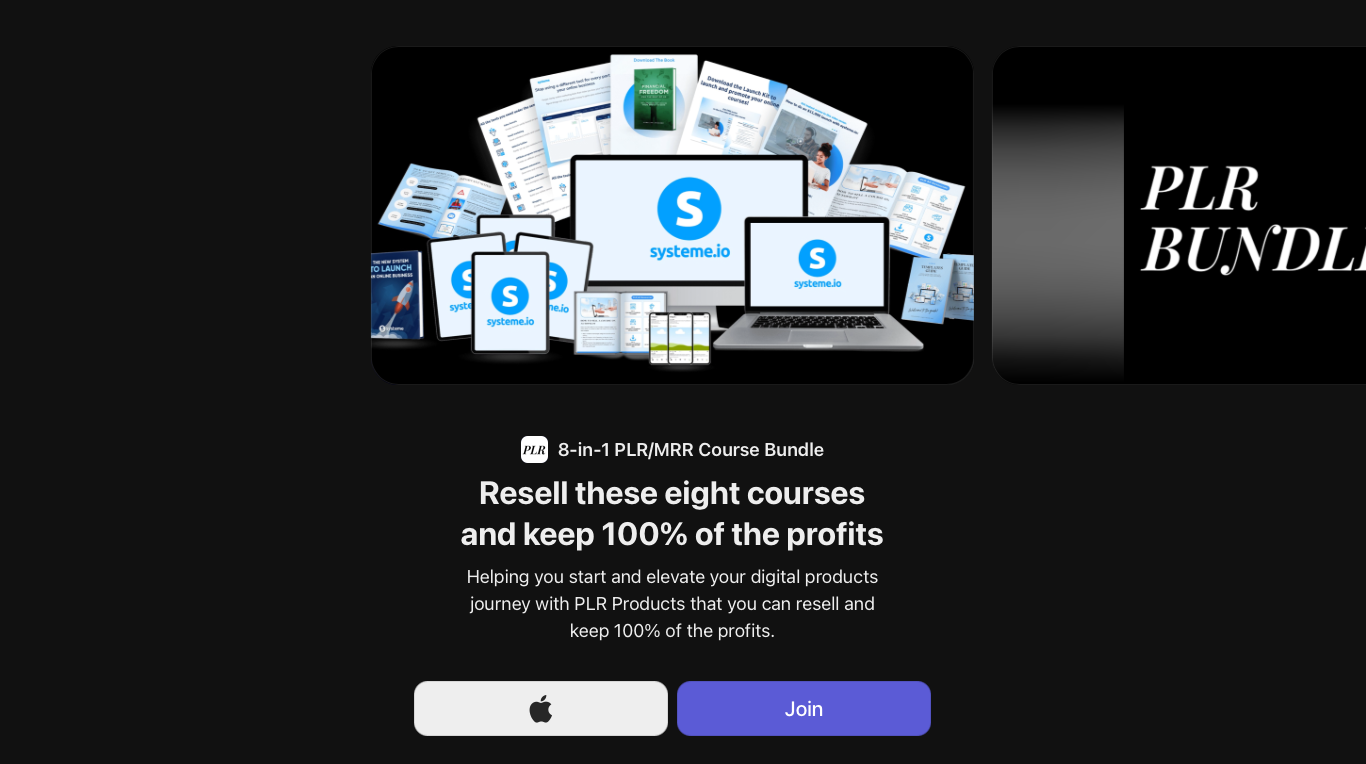
Online courses are the perfect MRR product because they can be relevant for just about any kind of business. Whether you sell digital products, physical products, or services, you can offer MRR courses related to your field.
For example, a financial consultant could offer some courses on basic financial literacy or an arts and crafts store could sell some courses on how to crochet or use various art tools.
Of course, you can also make online courses your main product type and supplement your own original courses with MRR courses to create a bigger product catalog.
If you buy MRR courses rather than PLR, make sure to click through the content at least once to check out the quality and ensure everything is relevant. Some courses are sold in bundles of 100 or more products for just a few dollars, so you can’t expect every course to be a winner.
Quality is still important even when you’re not making the products yourself, so don’t sell anything that doesn’t meet your standards. MRR courses usually come as a bundle of files you can sell as downloadables or upload them into a course maker on a specific platform.
For example, if you want to add an MRR course to your whop, you could use the Courses app to upload the different PDFs and videos so people can work their way through the content without downloading it.
Doing all of this is super quick, and then, all you have to do is market your products and watch as the money starts rolling in.
2. Ebooks
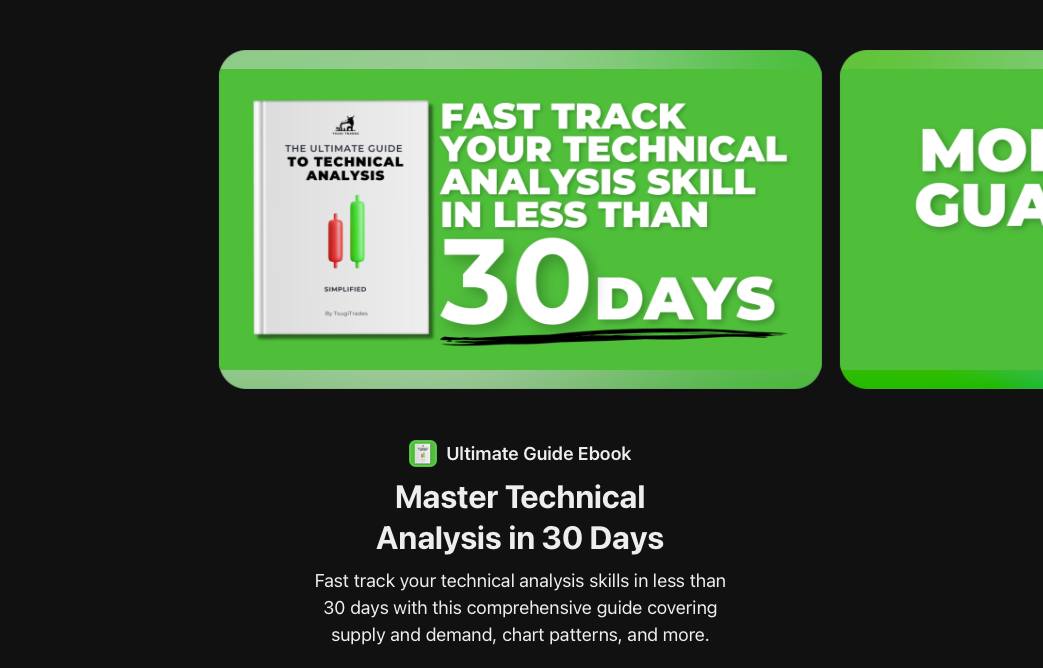
Ebooks are another great MRR product and you’ll find thousands of them available for sale on various websites, including Whop.
Because you can’t edit MRR ebooks, you’ll need to use the cover they come with and keep any author names as they are. This isn’t the end of the world, though.
If you also sell original or PLR ebooks with your own name on them, you can just add an "Other Authors" category to your store and sell MRR products there. You can also promote them as your personal recommendations to keep the focus on you and your brand.
Selling MRR ebooks is a particularly good fit if your business is centered around teaching.
You might offer courses, consulting sessions, or run an exclusive community aimed at sharing your expertise. Relevant ebooks are a great extension of that, as they add value without taking up a lot of time for you as a creator.
Ebooks are also great for influencers because you can sell self-help and lifestyle books that reflect your brand.
For instance, a TikTok influencer who posts lots of videos detailing their morning and nighttime routines could sell ebooks that teach people how to become a morning person. (I'd read one, because I am most decidedly not a morning person.)
No matter how many ebooks you want to sell, Whop can handle your entire catalog. You can start selling in minutes, and it's completely free, so even if some books don't get a lot of sales right away, you're not losing anything.
3. Social media content
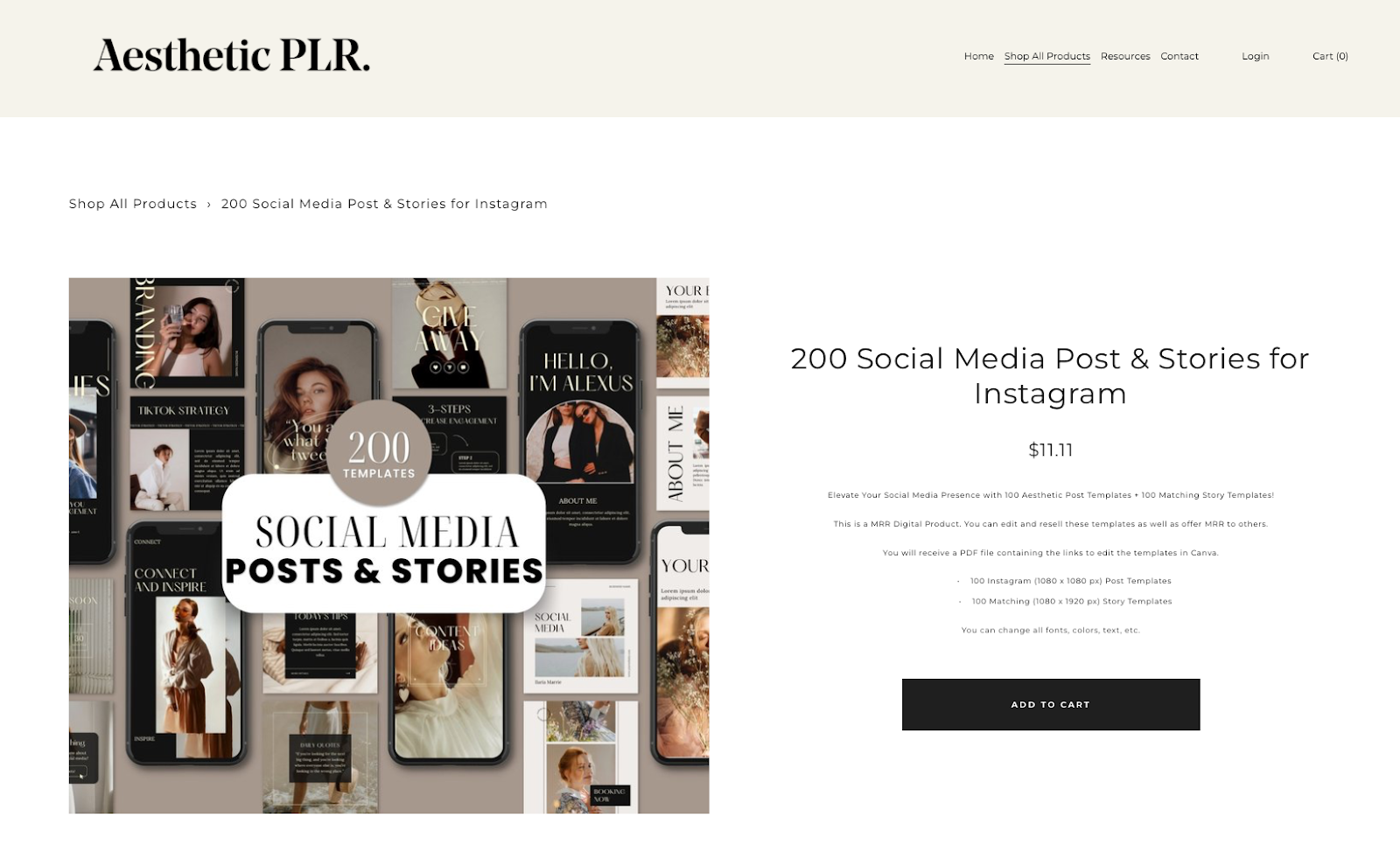
Another great use of MRR and PLR is social media content. There’s a range of different product types that fall into this category, including:
- Social media templates that you can add your own text and images to
- "Made-for-you" posts with quotes and images that you can post as is
- Videos with customizable hooks and captions
- Faceless content for creators who don’t share their identity
- Platform-specific content like Instagram Reels and Stories or Pinterest Pins
Growing audiences on social media is all about publishing content frequently and consistently. MRR products can help make this a whole lot easier.
You can weave in templates and made-for-you posts with your own original content and double your output without putting in double the effort. Win-win!
The high-quality images and video available can also add some professional vibes to your account, which is always helpful. You can even buy these kinds of products alongside a content plan that tells you (and your customers, if you're reselling) exactly what to post and when.
Many social media platforms have rules against publishing "unoriginal content" but this usually applies to reposting other people’s work. Since you and your customers own the rights to the templates and imagery you’re using, there shouldn’t be a problem.
Whether you’re growing a brand or just growing an account, MRR products like this can help you cut back on the work and focus on evolving your business.
4. Digital organizers and planners
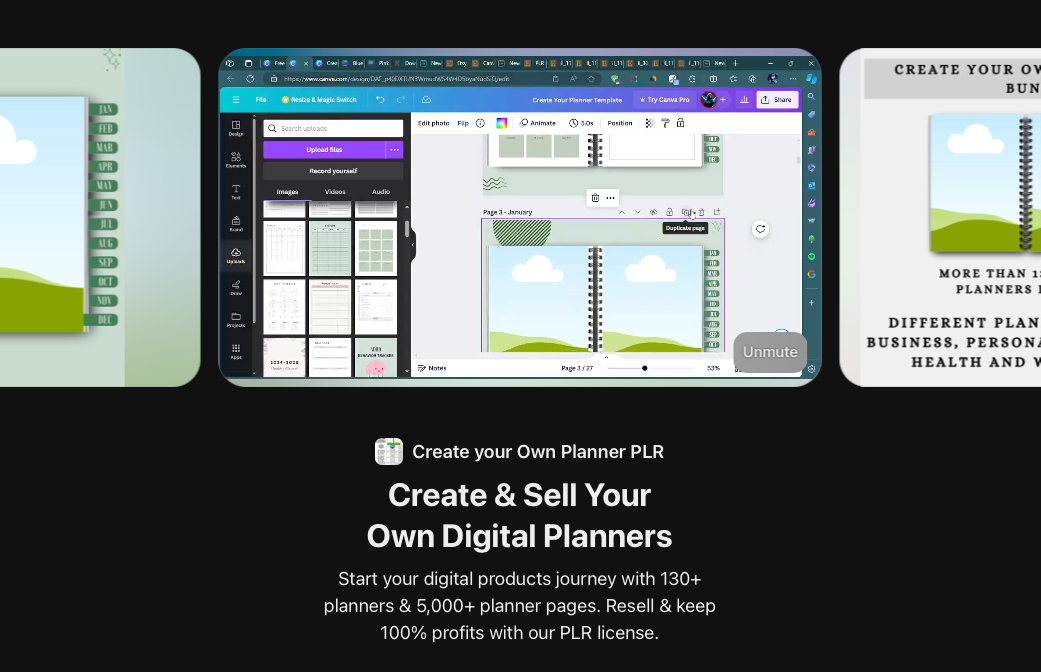
Digital planners and organizers are hugely popular right now.
By downloading the templates to a tablet or PC, you can create a super cute journal or meticulously plan out your day just by filling in all of the premade fields. And as with all digital products, the beauty is in the variety.
Here are just some of the products you’ll see:
- Journals
- Mood trackers
- Daily planners
- Study planners
- Meal planners
- Diet organizers
- Business plan templates
- Personal development planners
- Content schedules
- Health trackers
- ADHD behavior trackers
- Parenting organizers
These products are particularly great if you get them with Private Label Rights because it’s so easy to edit the colors to match your branding and add your own logo. With barely any work, you’ll have personalized and professional merchandise to sell on your online store.
With Whop, you can sell these downloadables in a range of different ways. You can list them as individual products, bundle them together, or even give people access to a growing catalog through a subscription.
You could also give them away as freebies or use them as lead magnets to encourage new visitors to do something, such as signing up for your newsletter. On MRR/PLR websites, you can buy thousands of planner templates for as little as $10, so you won’t feel bad giving them away for free!
In terms of format, digital planners usually come as PDFs, Canva templates, or Notion templates.
5. Digital stationery
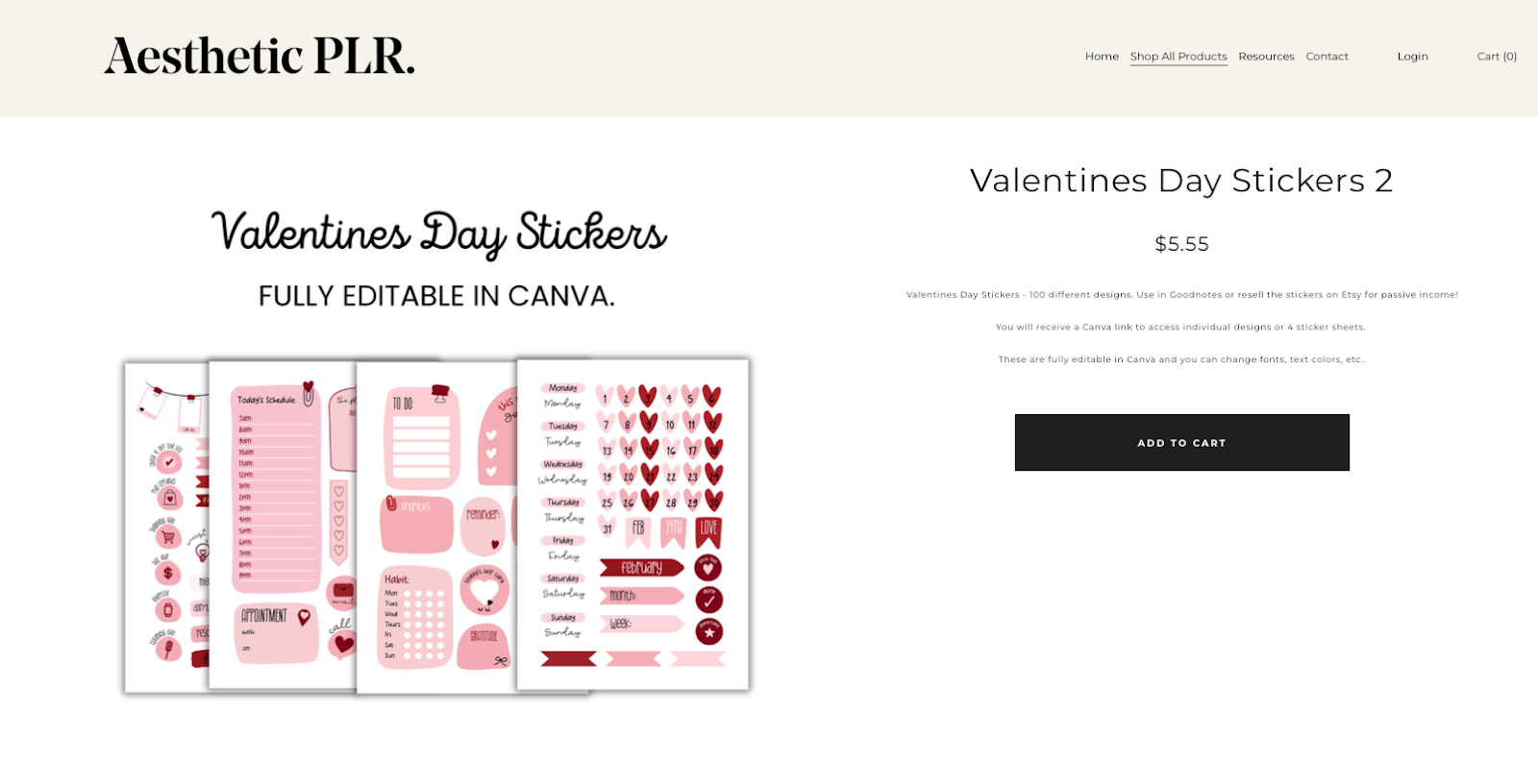
As well as planners and organizers, there are also various types of digital stationery you can buy.
Some products can fall into both of these categories at the same time, but in general, products that are more practical fall into the planner category, and products that focus more on aesthetics are considered stationery.
Stickers, coloring books, and bullet journals are good examples of stationery. There are also more niche examples like recipe card templates, greetings cards, checklists and to-do lists, and memos.
Another nice thing about digital stationery is that it doesn’t have to stay digital. You can also market them as printables that your customers can print out and turn into physical products if they want to.
If you sell planners and organizers in your store, stationery like stickers can make great add-on products that you can upsell. Digital stickers are just images that you can drag and drop onto files, so you can use them with lots of planner products.
And like organizers, they also make great freebies. You can send your customers some free Christmas stickers during the holidays or give them some coloring book pages on their birthday. That kind of stuff is bound to help you stay at the top of their minds when they're ready to buy something.
6. Software
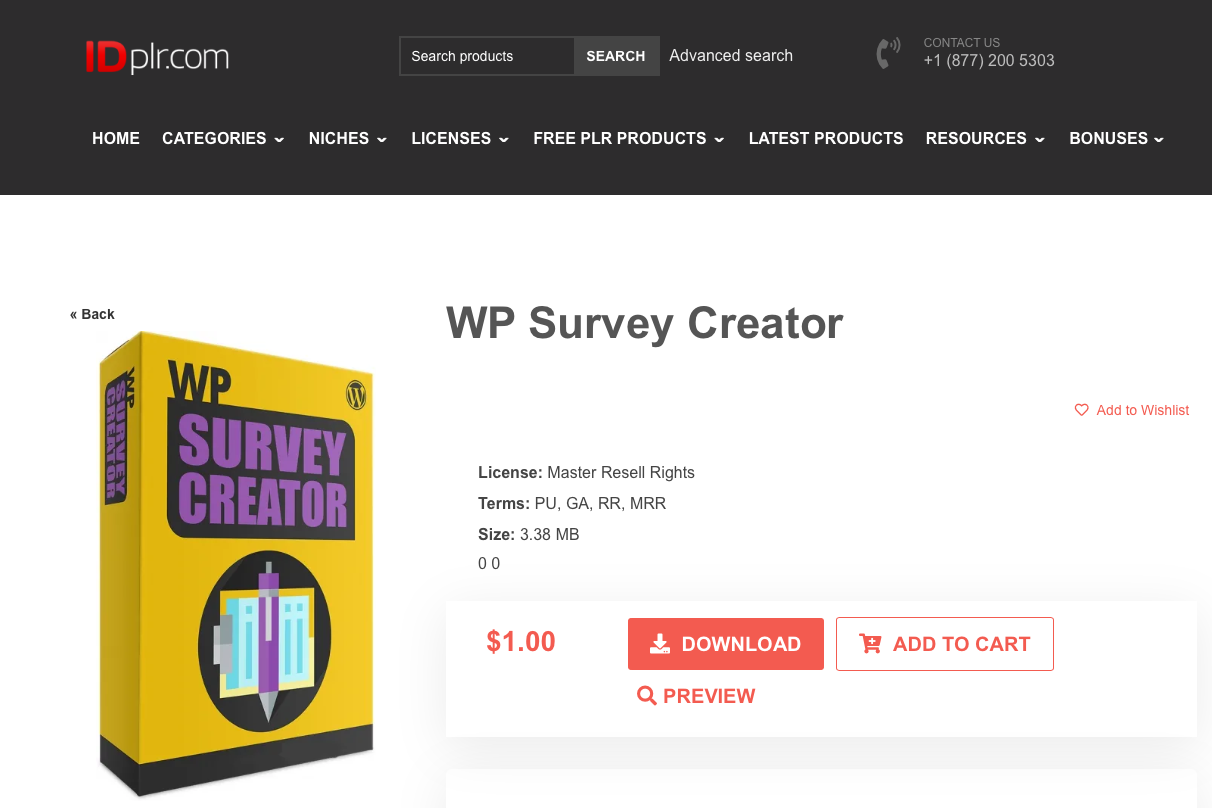
Selling software on your online store sounds pretty impressive and you might think of it as something only tech-savvy people can do, but with MRR products, anyone can add a few pieces of software to their product catalog.
Since you didn’t make the software yourself and you can’t maintain it, PLR software tends to be simple programs that don't need any upkeep.
That means things like survey creators, online course makers, template builders, website builders, graphic design software, website add-ons for analytics, ecommerce software, and more.
MRR software tends to be stuff you can get in lots of other ways too, so that's one downside. On the other hand, SaaS (Software as a Service) is so popular nowadays that nearly everything is a subscription rather than a one-off purchase. People who aren’t into that model are always on the lookout for alternatives with a one-time fee.
As always, make sure to check out your MRR products before you put them up in your store. Random software can be buggy or even malicious so definitely make sure you buy from a place you trust and test it out first.
7. Articles and blog posts
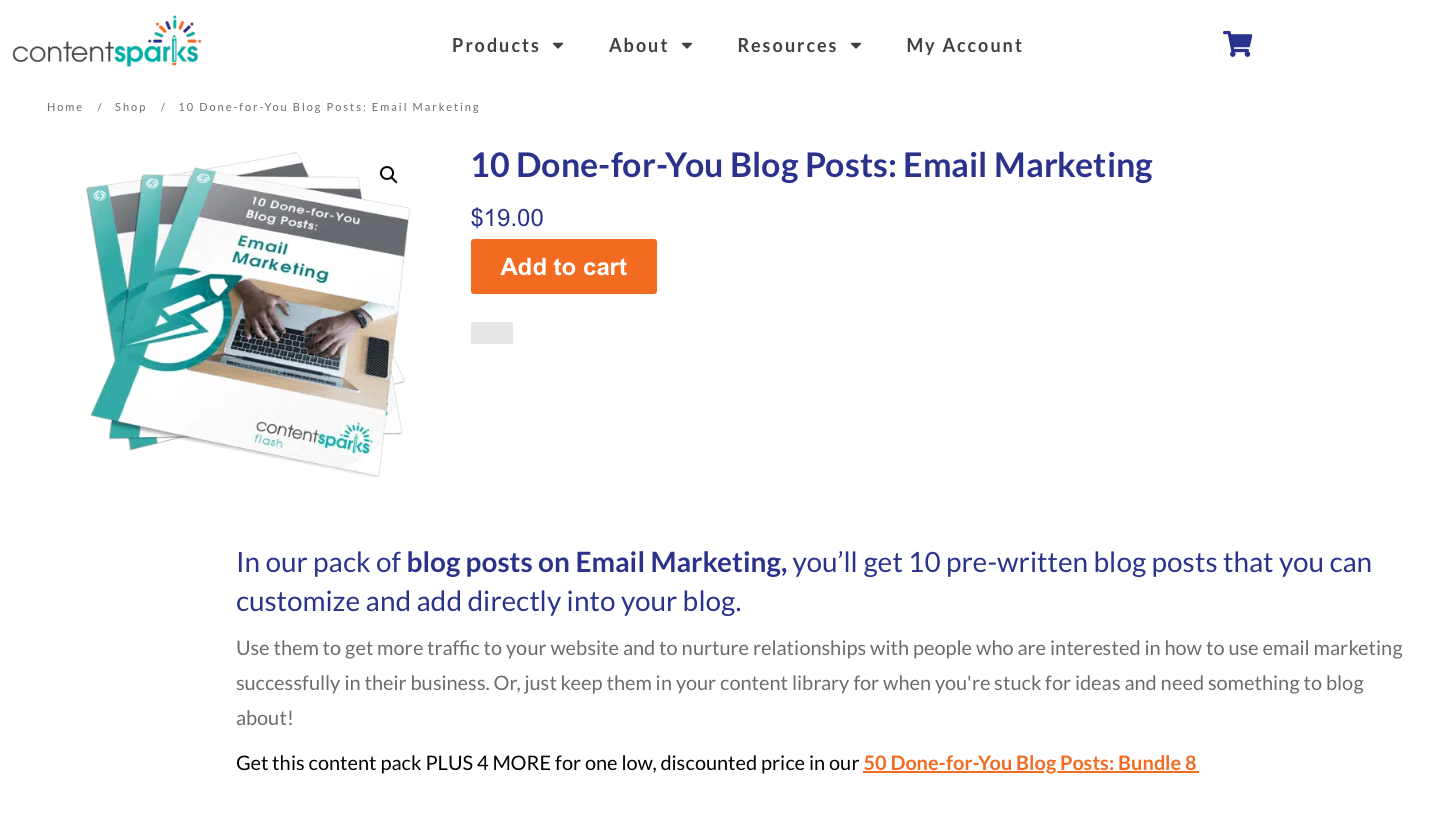
Content marketing is a huge part of running a successful online business and for many companies, blogging is a core part of their content plan. Blogs are great because all of the regular search engine-optimized posts keep Google happy and drive traffic to your website.
Paying for freelancers to write good content for you, however, can get pretty expensive. With MRR and PLR articles, your customers can buy well-written and fact-checked content for a fraction of the price that they can put right on their website.
Not every post on a blog needs to be original content specifically about the brand and its products, so a bundle of articles on relevant subjects can actually work really well.
And even if they’re MRR products that can’t be edited, your customers can still add a CTA (Call to Action) at the bottom of the page to direct readers to their products or services.
Don’t forget that you can use these made-for-you products, as well. You can make money by reselling them but there are also situations where you can save money by using them. So if one of the articles in your bundle would be perfect for your own website, go ahead and use it!
8. Lead magnet templates
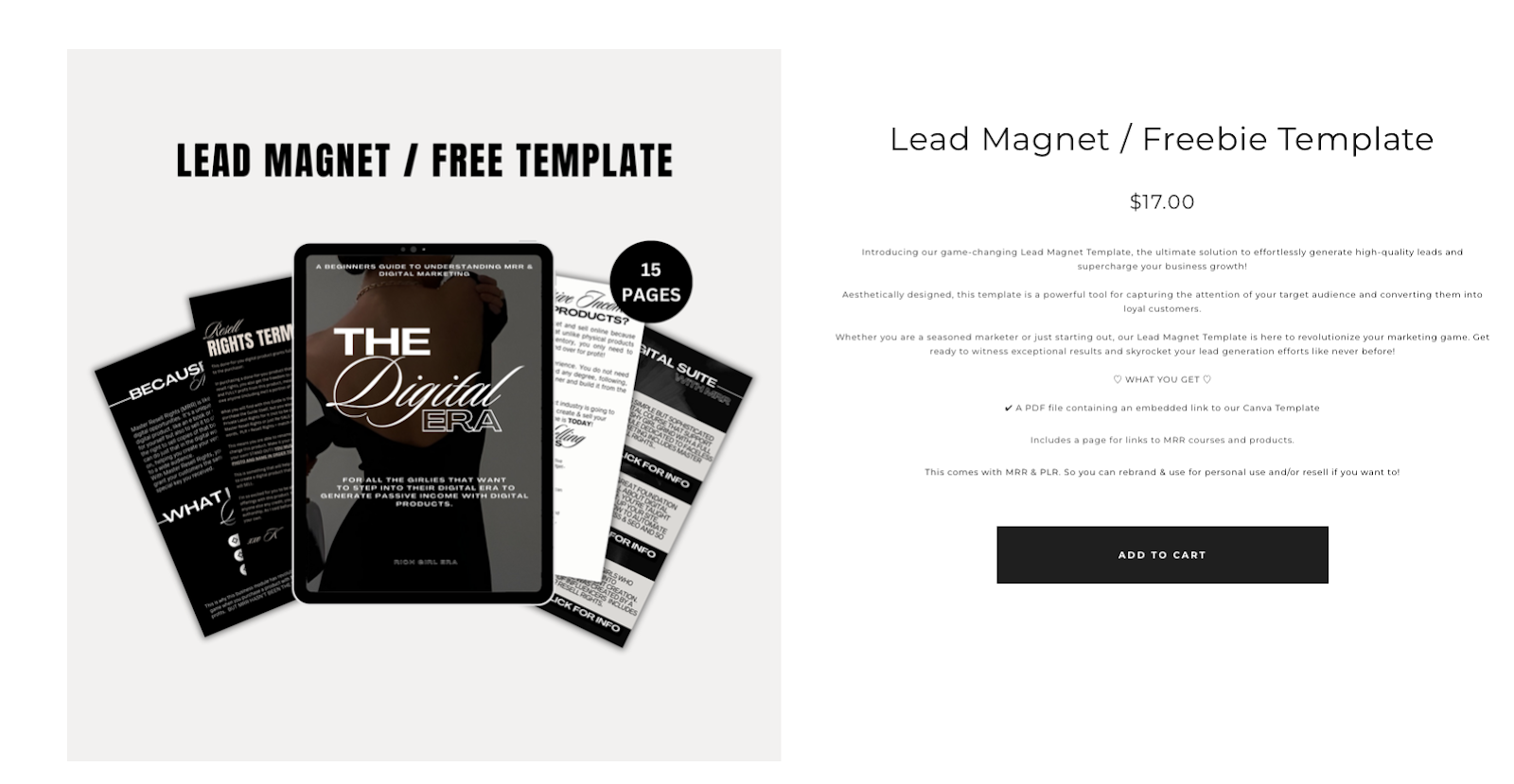
Lead magnets are all about encouraging visitors to give you their contact details. Whenever you visit a new site and you get a popup offering you a discount code if you sign up for a newsletter—that’s a lead magnet.
But discounts aren’t the only thing companies can offer. They could give away a small digital product, a free trial, or anything else that fits their business model.
When it comes to done-for-you digital products, you can resell professional-looking templates that your customers can add to their websites and encourage visitors to sign up. You can also sell bundles of digital products that can be used as freebies.
Pro tip: You can even use these MRR lead magnets yourself.
If you’re working with an ecommerce platform rather than your own website, you won’t need the popup but you will need to make sure your platform allows you to add free products (this isn’t a guarantee!).
With Whop, for example, you can add free-to-download products, offer free membership tiers, host free events, and more.
Anything you can sell on Whop for money, you can also offer for free. People can get a free taste of your content before committing to a subscription, which is a great way to turn visitors into customers.
9. Sales funnels
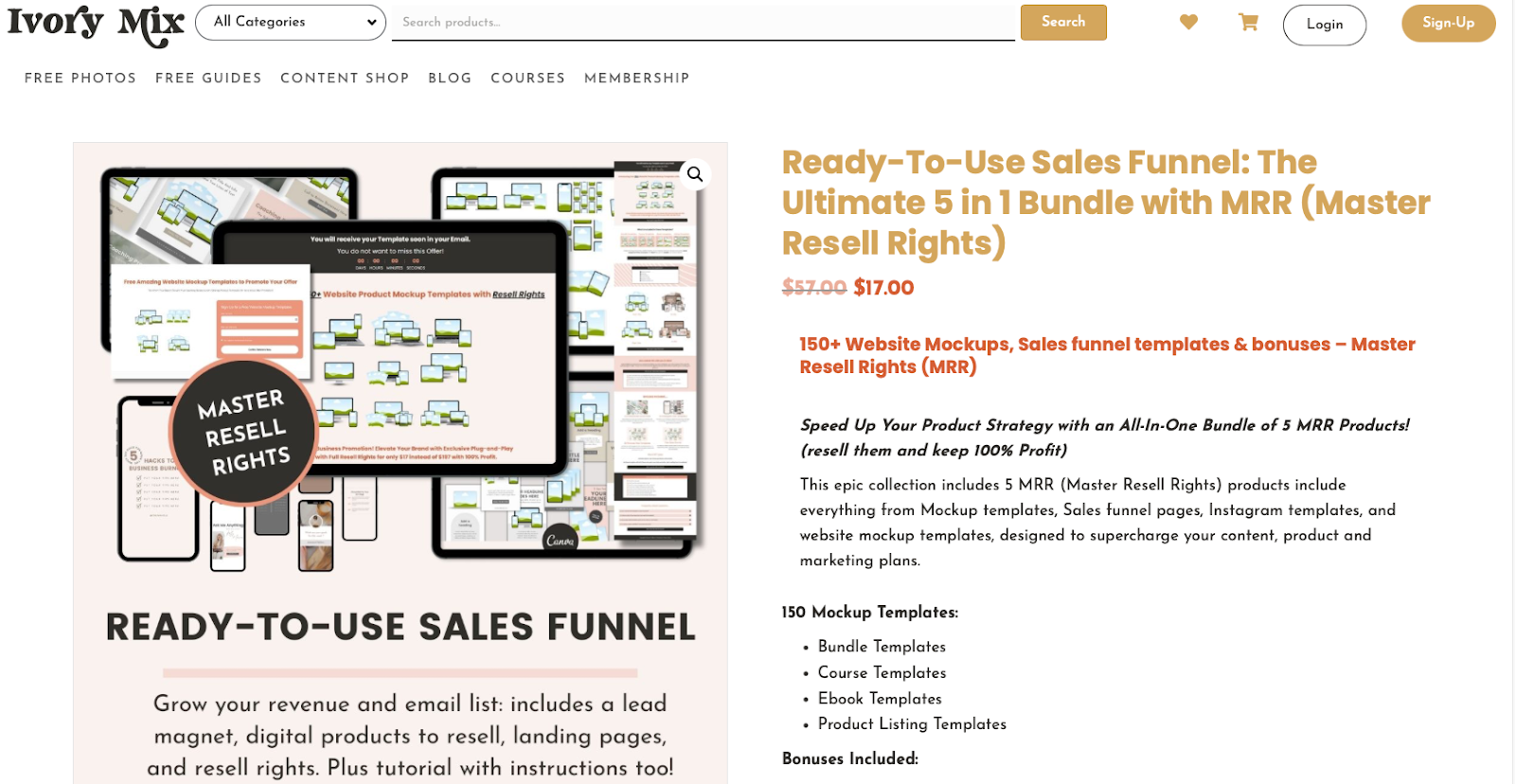
If your business is all about helping your customers achieve their own success, MRR sales funnels could be a great addition to your product lineup.
Customers join exclusive communities and buy online courses about how to succeed in ecommerce or social media because they want to avoid the trial and error phase and launch a business as smoothly as possible.
By offering pre-made sales funnels, you can give your customers access to a lot of the important things they need to start selling so they can do things quickly and easily.
A sales funnel usually comes with some lead magnets, digital products to resell, landing page templates, social media templates, plus marketing templates and tools.
Not only will they be able to skip making a load of graphic design assets themselves or hiring a freelancer, but they’ll also end up with higher-quality results than most beginners could manage.
Sales funnels are great as add-on products for online courses and ebooks about ecommerce, and they would also make a great freebie for customers who book an exclusive one-to-one call or join an expensive membership tier.
10. Email templates
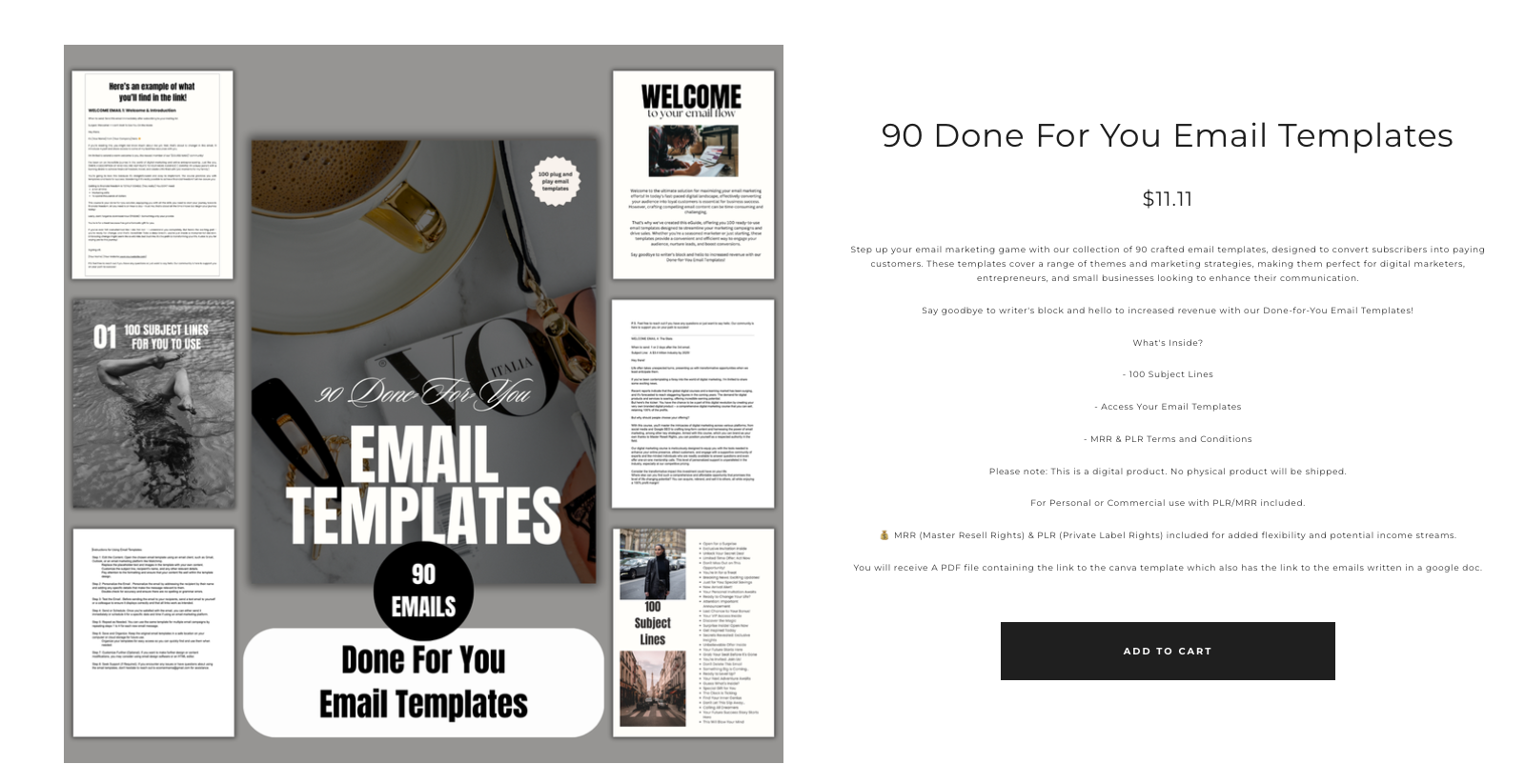
Done-for-you email templates are another great product to offer new business owners and entrepreneurs. Email lists are very valuable assets for businesses but it’s not easy to establish and grow them.
With all the other things a person has to deal with when starting a business, it’s easy for email marketing to end up getting overlooked. With PLR email templates, you can offer your customers a way to increase their output without putting in more effort—and that’s always a tempting prospect.
You’ll be able to find PLR email template bundles on all kinds of resell rights websites, covering many categories and designs. And since you don’t have to make the content yourself, you can offer as many different bundles as your customers need.
If you want to use PLR email templates for your own business, you set up a comprehensive email marketing campaign with Whop. Thanks to the integration with Mailmodo, you can easily send newsletters and updates to your entire mailing list.
Combine this with made-for-you emails and you’ve got a pretty effort-free setup!
11. Print-on-demand designs
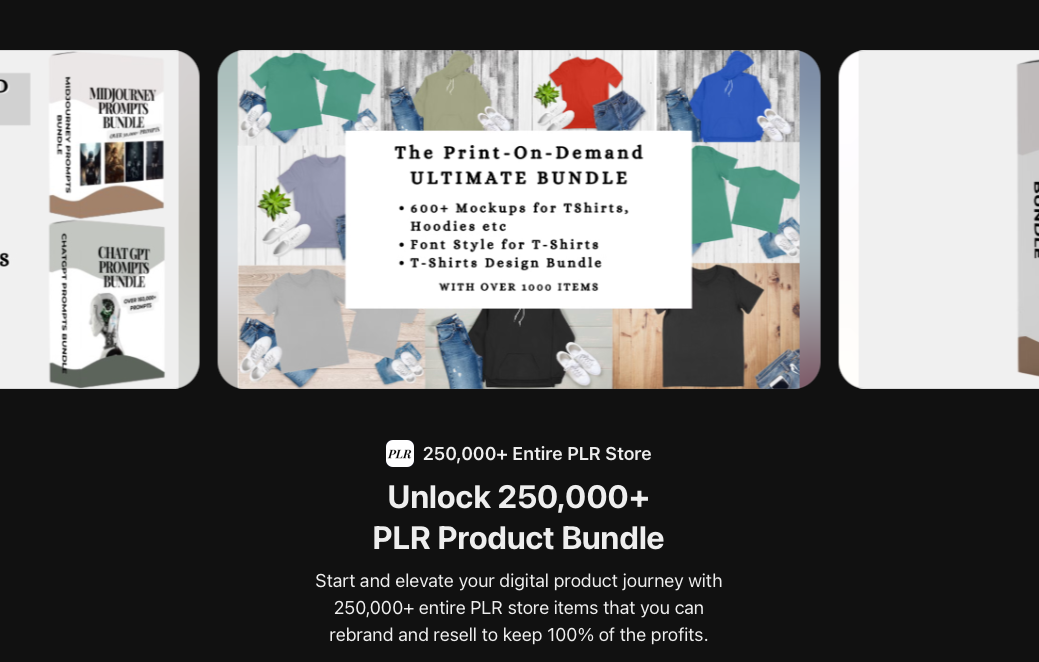
By combining the print-on-demand business model with PLR designs, you can create a passive income stream with almost no effort at all. All you have to do is buy a PLR design bundle, make an account with a PoD platform, and upload your favorite designs from the bundle.
It could all be done in a day and after the setup is finished, you can literally walk away and let people find your designs through the platform. It won’t make millions, but it’s a fool-proof strategy if you’re just getting into online side hustles and ecommerce.
Or, if you want to make your own designs but don't have the time to make them quickly, PLR designs can bulk up your catalog while you add original pieces bit by bit.
You can also choose to resell the bundle as is so your customers can use it to create their own passive PoD income stream. Since you can pass the resell rights on to them, they can sell the designs freely in just the same way.
If you’re just looking for income streams rather than building a brand, you can even do both—just upload your favorite designs to a site like Redbubble and also throw the bundle up on a site like Whop.
12. AI prompts
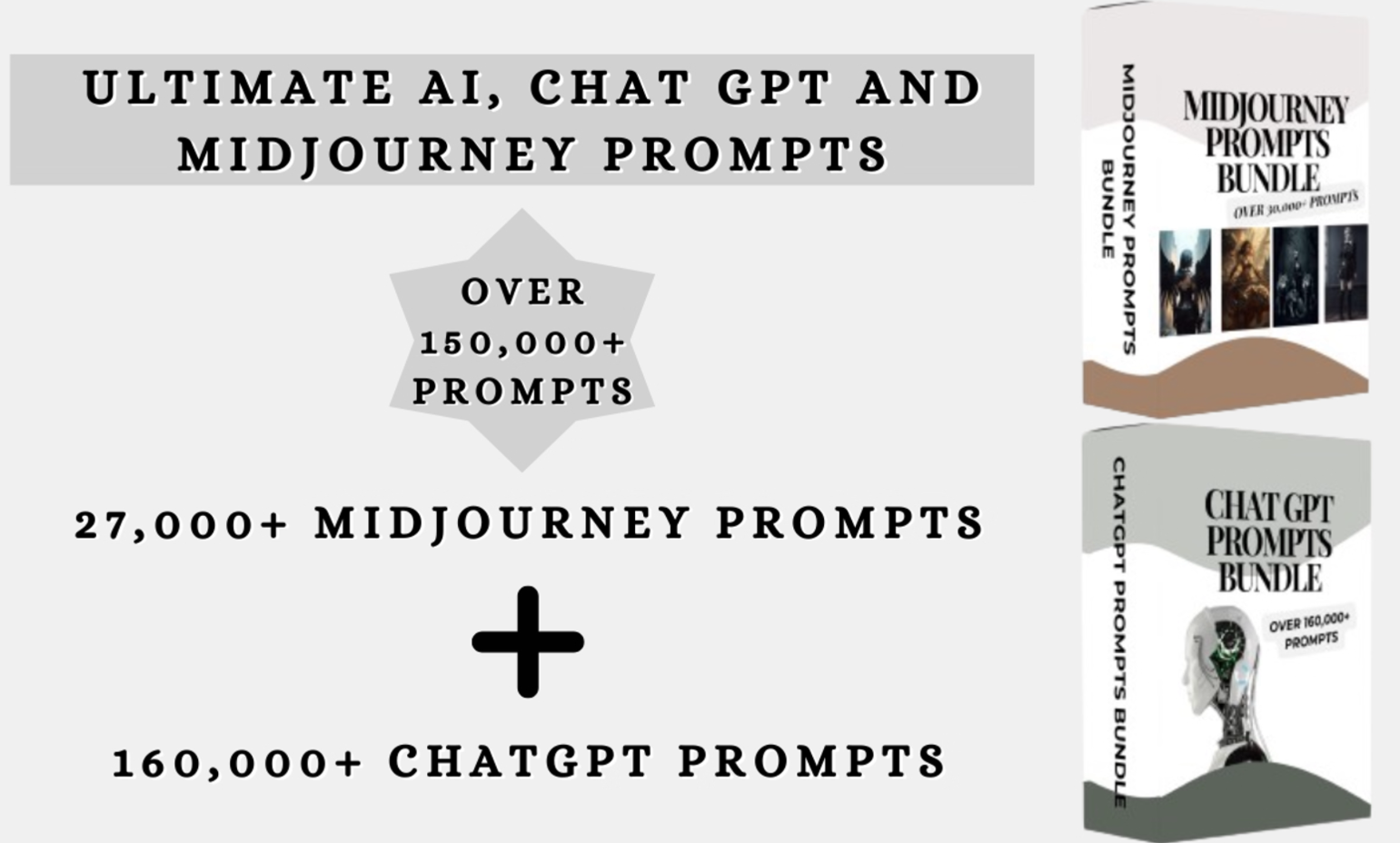
Ah, AI. The buzzword that keeps on giving.
It’s been a while now but the hype around AI is not dying down. That’s good for us because it gives us a whole new digital product category: AI prompts. As easy as it is to use AI in general, getting high-quality results is actually pretty tricky.
The AI models like ChatGPT respond best to certain kinds of instructions presented in a certain kind of way—and if you buy ready-made prompts, you can skip the experimentation and get straight to the stuff you can actually use.
AI prompts are another good product if you’re teaching people how to win on social media or create their own ecommerce store since they can help people get personalized website copy and imagery without a huge price tag.
Everyone knows that AI doesn’t give perfect results, though—so I’d recommend being honest about that. Don’t use product thumbnails showing non-AI art and imply that people will be able to get amazing professional results because that’s not the experience most people will have.
It’s already amazing that we can get usable art and usable copy just by typing in what we want, so there’s no need to stretch the truth and make out that it’s exactly the same as hiring a human with years of experience under their belt.
You can also sell these prompts alongside stationery and other products because there are people who like to mess around with AI generation for fun. You could even create some product imagery for your prompt bundle using the prompts.
That’s the beauty of MRR and PLR products, you can both use them and sell them! With huge bundles of over 100,000 prompts, you can also split them up into smaller chunks to sell or start a subscription that comes with around 50,000 prompts and adds 1,000 more each week or month.
How to buy MRR products
There are two different ways you can get your hands on the Master Resell Rights or Private Label Rights for a product—buy from resell rights websites or go directly to the creator.
Resell rights websites
Buying from websites is the easiest option and there are hundreds and hundreds to choose from. Unfortunately, illegitimate websites do exist and they sell products with fake resell rights—of course, you want to stay away from these kinds of sites.
If you want to check whether something is legitimate or not, the best thing to do is look up reviews of the site and try to find the same products somewhere else.
Thanks to the nature of MRR products, they will always be for sale in multiple places (unless you’re looking at a brand-new product).
If the rights are fake on the other hand, you likely won’t see the products on other resell rights websites and you might even find the original creator instead. Either way, there are thousands and thousands of legitimate MRR products out there, so if you’re getting dodgy vibes, just leave it and try looking somewhere else.
When you decide to buy something, always read the resell rights since different products will have different rules that were decided by the creators when they originally sold the rights. If you’re on a budget, some sites sell bundles for just a few dollars or even have a free PLR section.
Buying from creators
If you want to get your hands on some more bespoke and original MRR products, you can also approach creators and try to make a deal with them.
This is high effort because you have to find products yourself and there’s no guarantee that the creator will be interested in selling the rights to their work—but it’s also high reward because if it goes well, you’ll have access to products that other people don’t have access to.
Art, illustrations, and graphic design assets are the best kinds of products to get in this way. Social media is full of digital artists showing off their work and once you find their accounts, you have a way to contact them.
Not all creators need to be convinced to offer resell rights, however—some are already doing it. When you find a creator like this, make sure you bookmark their site so you can check out new products in the future.
Whop is home to several creators who sell huge PLR bundles, so make sure to take a look.
Tips for making money with MRR products
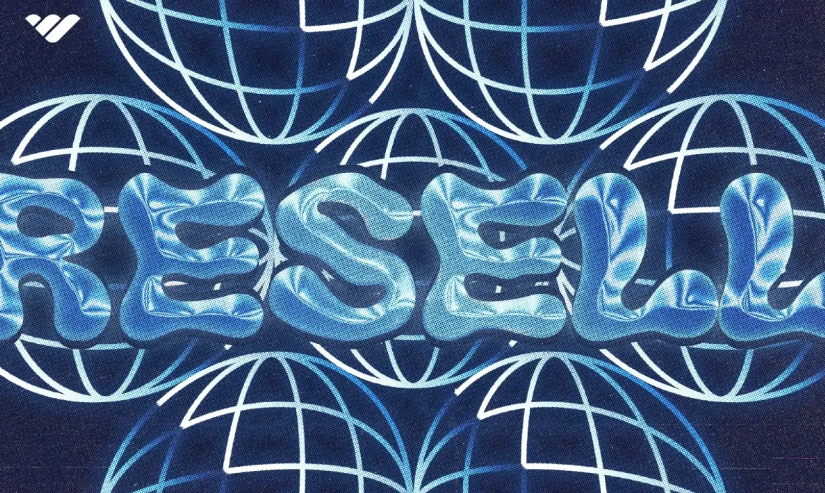
The draw of MRR products is that anyone can find products to sell without needing to create them directly.
This takes some of the work out of starting a business—but there are still some other areas you’ll need to put effort into if you want your products to sell.
Here’s what you need to do to grow an audience and make sure your MRR products are a huge hit.
1. Diversify your product catalog
Whether you’re adding MRR products to supplement original digital products or you’re creating a store using 100% MRR products, the key is diversity.
You know how annoying it is when you find a great piece in a clothing store but they only have three color options and they're all awful?
Well, by selling MRR products, you have the power to give your customers every color option under the sun.
You don’t need to limit yourself to one bundle of generic email templates—you can sell bundles covering all sorts of niches and design styles to give as many customers as possible the chance to buy exactly what they want.
Let's say that you run an exclusive community teaching people how to get into ecommerce. Great news: You can diversify your core offerings with other resources that will help your students.
There could be an ebook covering ecommerce basics or social media templates to help with marketing efforts, alongside content scheduling planners to stay organized.
You could offer lead magnets and sales funnels for them to use in the new ventures—there are so many related products that could bring extra value to your customers.
Using MRR products is a quick way to add more value to your entire catalog, and that's pretty awesome.
2. Add branding and detail to your product pages
If you’re buying MRR products, you can’t claim authorship or modify the product—but that doesn’t mean you can’t make a fancy product page.
By putting unmodified images of the product on a background with your brand’s colors and logo, you can add a bit of brand identity and professionalism without breaking the resell rules. (Still, make extra sure that this is allowed, because it all comes down to what the seller agreed to.)
Another important part of the product page is the product description.
Some MRR product sellers just put their stuff up for sale and leave it at that. They don’t know what’s in there and so their product description is vague and unhelpful.
Don’t be like those sellers.
It’s crucial to make your products easy to buy, and the more information you can provide, the better. Look in the bundle, see what’s there, find out what kind of people and projects it would work well with, and then put all of this information in your product description.
Tags are helpful too, where applicable. They help people find your products.
3. Engage in digital marketing
MRR products need to be marketed just like any other. To promote your online store, you need to create accounts on multiple social media platforms and start creating content.
Socials are one thing. You can also take your efforts one step (or twelve) further.
Need examples? You could start an email marketing campaign. If you've got money to spare, try out a paid ad campaign.
For small online businesses, however, social media is arguably the most important type of marketing right now.
You can make fun videos, show off your products, participate in trends, interact with people, and host competitions and giveaways all from the same place.
You can also pay for enhanced visibility by hosting your store on a platform like Whop. With Whop, you can bring customers in from Google or social media links and when they make a purchase, you'll keep up to 97% of the profits.
However, you can also choose to take advantage of Whop’s Discover page where millions of customers are searching for products.
It’s more expensive, but in return, you get access to customers who wouldn’t have found you otherwise. This can multiply your profits by a lot.
4. Personalize your PLR products over time
Starting with MRR products that you can put up for sale straight away is a great idea to get your store set up quickly.
However, PLR products that you can modify and make your own are super important if you want to create a brand identity and keep customers coming back for more.
So, after your shop is set up, it’s a good idea to buy some PLR products and start editing them. Once they’re all done, you can add them to your store one by one, slowly expanding your catalog and increasing product quality.
When you buy PLR products, you’ll be given editable files and templates rather than printables like PDFs. Canva is a hugely popular platform for this because you can make unique templates for all kinds of formats that are super easy to modify.
When you buy a PLR coloring book or PLR social media posts, they will sometimes come with a link to the Canva templates for you to edit.
This is often the same for ebooks. If you buy an MRR ebook, you’ll often get an EPUB file or a PDF file that you can’t really edit and can only resell as is.
A PLR ebook, on the other hand, is likely to be a Canva template. You might associate Canva with logos and graphic design, but it also has layouts for all sorts of ebooks.
While editing a PLR product is definitely more effort than just buying a ready-to-go MRR product, it’s really not that hard. For some products like planners, stationery, and templates, all you have to do is edit the colors and add your logo.
For ebooks and online courses, you can supplement the original content with some of your own thoughts and experiences, and remove anything you don’t really agree with.
This is probably the most time-consuming task, which is why it’s okay to take your time and just add the product when it’s done rather than trying to complete it before you launch your store.
5. Create your own MRR/PLR catalog for other sellers
Lastly, always remember that you have two options when it comes to MRR products—you can sell them to your customers as products for personal use or you can sell them on with the Master Resell Rights so your customers can sell them too.
In most cases, your business will suit one of these options more than the other. For example, a lifestyle influencer with a merchandise store would usually stick to PLR products that they can add branding to and sell to their fans for personal use.
Someone who trades in business advice, on the other hand, could sell their MRR products for customers to use with their own businesses.
In some cases, however, it's possible to do both.
For instance, an ecommerce influencer might sell a bundle of 100 MRR ebooks for their customers to sell and also offer a branded PLR ebook about how to run an online store. This is a super flexible business model, which is why I'm a huge fan of it.
Sell your digital MRR products with Whop!
Whether you’re mixing MRR products with original products, creating a catalog of branded PLR products, or reselling MRR bundles, you need an ecommerce platform that offers flexibility and specializes in digital products.
That’s where Whop comes in.
When you make a whop, it starts off as a blank slate and you can add all the tools you need to make it into the perfect storefront for you.
If you want to sell online courses, you can add the Courses app and if you want to sell downloadables, you can add the Files app.
You’re free to add as many products as you like and sell them however you want to. Create bundles, subscriptions, freebies, and discounts with just a few clicks.
And as for the type of products you can sell—well, everything I've mentioned in this guide is sellable with Whop. Courses? Check. Ebooks? Of course. Downloadables? Anytime!
To be more precise, you can sell any and all digital products with Whop, and it only takes a few minutes to get started.
With your MRR products sorted in a few minutes and your store set up in a few more, you could literally start selling before the day is over—so what are you waiting for?

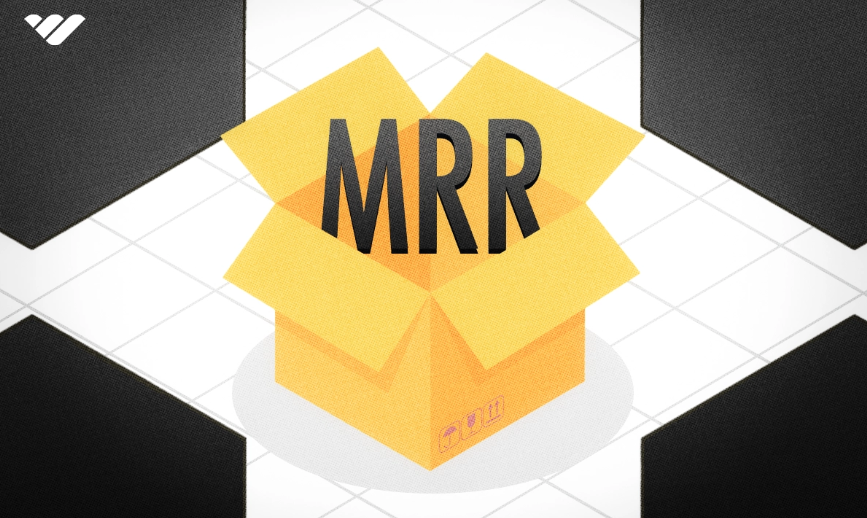
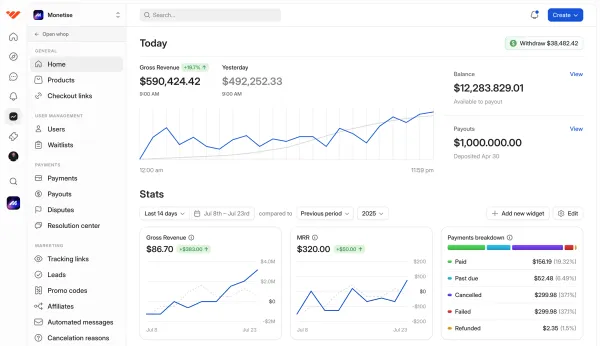
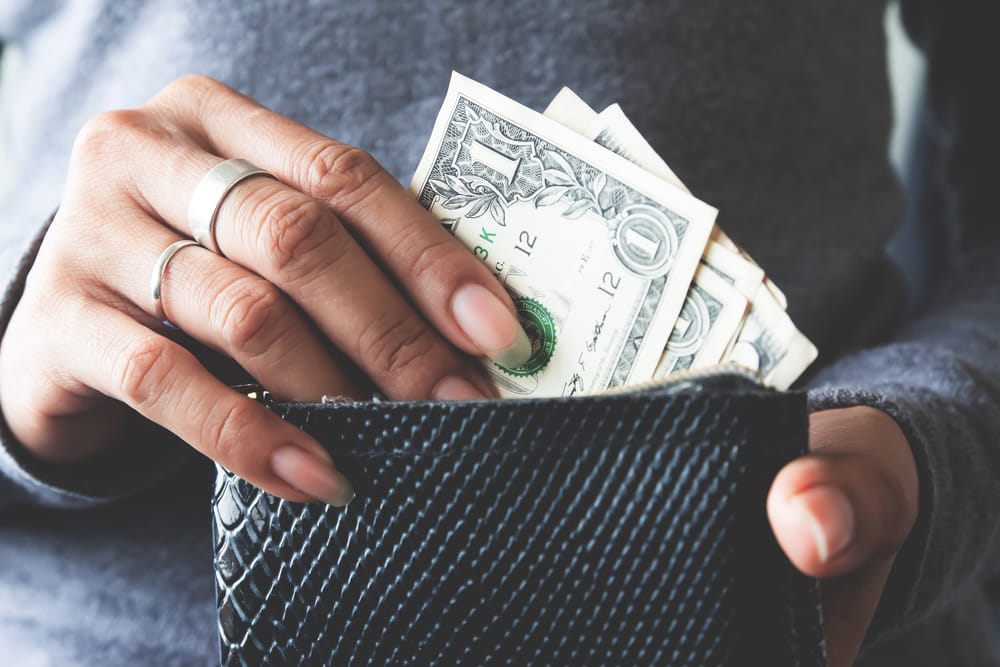



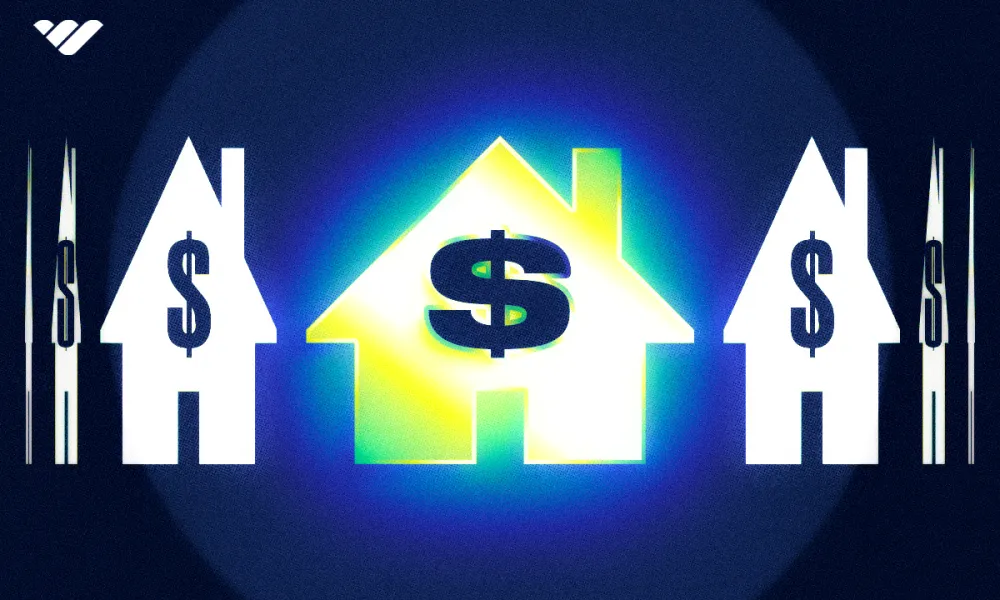
![80 remote side hustles to make money from anywhere [2026]](/blog/content/images/size/w1000/2025/11/tablet-designer-home-opt.webp)
